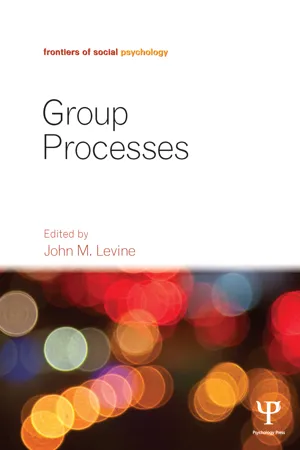Psychology
Majority and Minority Influence
Majority and minority influence refer to the ways in which groups can shape individual behavior and attitudes. Majority influence occurs when the larger group's opinions or behaviors influence those of the minority. Conversely, minority influence occurs when a smaller group's views or actions lead to changes in the majority's attitudes or behaviors. These concepts are central to understanding social dynamics and conformity.
Written by Perlego with AI-assistance
Related key terms
10 Key excerpts on "Majority and Minority Influence"
- eBook - ePub
Majority and Minority Influence
Societal Meaning and Cognitive Elaboration
- Stamos Papastamou, Antonis Gardikiotis, Gerasimos Prodromitis(Authors)
- 2017(Publication Date)
- Routledge(Publisher)
minority was the prime. Apparently, the mere attribution of majority status triggers an automatic and positive initial dispositional response.p.48 Unpacking majority influenceIt should be understood that the majority’s advantage is not absolute, its privilege is not always honoured, and the norms of ‘proper’ behaviour are not always followed. Majorities are often met with stiff resistance and little overt change on the part of their influence targets. A voluminous research literature attests that the leader of a group, who presumably represents the majority of group members’ beliefs, is not always followed, and may be unceremoniously dumped, even by those whose loyalty might otherwise be taken for granted (Alabastro, Rast, Lac, Hogg, & Crano, 2013; Hogg, 2012, 2013; Rast, Hogg, & Tomory, 2015). In other contexts, the changes that the majority induces are ephemeral and quickly reversed. In yet other instances, the majority appears to have a persistent effect on the beliefs and actions of its targets. To understand social influence, then, which more often than not refers to majority influence, it is essential to appreciate the factors responsible for the variable outcomes of majority influence efforts beyond the usual shibboleths of brute force, threats, and continuous, intense surveillance, because studies of majority influence often are conducted in ways that negate even the possibility of the majority applying retribution or maintaining surveillance over its potential influence targets.Threats and surveillance: the ‘brute force’ viewSurprisingly, the processes responsible for the variable outcomes of majority influence, its successes and failures, are under-studied in social psychology. It is true that majority influence has come to be viewed as considerably less interesting than minority influence, as it was characterized as involving the rather mundane processes of coercion and surveillance. As will be shown, however, this has been revealed as a shortsighted view. Majority-induced change was thought to result in little cognitive readjustment and thus ultimately to involve only short-term compliance rather than processes of cognitive reorganization and internalization, which may result ultimately in long-term behaviour change. Although compliance and internalization have been studied at least since the 1950s, the focus on force and threats as the principal tools of the majority has not changed much in the past half-century (Kelman, 1958). The stress on minority influence, on the other hand, was carried forward by a need to understand the processes by which an individual or group with little or no apparent power could move the majority to its way of thinking. - eBook - ePub
- Jane Callaghan, Lisa Lazard(Authors)
- 2011(Publication Date)
- Learning Matters(Publisher)
However, much research that has developed Moscovici’s premise has focused on individual cognitive processes rather than group dynamics. So, for example, Levine and Kaarbo (2001) suggest that the dominant approach to studying minority influence involves looking at the individual cognitive responses of majority members to a (often anonymous) person who holds a minority view. These studies explore how this apparent ‘minority’ influences attitude change (for example, Alvaro and Crano, 1996 ; Martin and Hewstone, 2003), or other aspects of cognition like problem-solving (for example, Smith et al., 1996 ; Van Dyne and Saavedra, 1996). For example, Martin et al. (2007) conducted experiments to explore the differential impact of Majority and Minority Influence on attitude-consistent behavioural intentions. They set up experimental conditions to explore whether minority or majority influence would have a bigger impact on the likelihood of people expressing behavioural intentions that were consistent or inconsistent with their existing attitudes. For example, participants read a counter-attitudinal message (opposed to voluntary euthanasia), and were asked to indicate whether they would sign an advance directive or ‘living will’, which would be used to prevent them from being kept alive under particular medical circumstances. Participants were told that the statement they read had been written either by a minority or a majority member - eBook - ePub
Social Influence
The Ontario Symposium, Volume 5
- Mark P. Zanna, James M. Olson, C. P. Herman(Authors)
- 2014(Publication Date)
- Psychology Press(Publisher)
prevail (Tanford & Penrod, 1984). Direct movement to the minority's views occurs on statistically few occasions. Private movement to the position advocated is seen more frequently (Moscovici, Lage, & Naffrechoux, 1969; Nemeth & Wachtler, 1983). However, more importantly, we have recent evidence that the conflict engendered by persistent minority opinions leads to a reassessment of the situation, to the detection of novel and correct solutions, and to thinking in more original ways. As such, we have come to recognize the importance of minority influence on the ways people think about an issue and about the quality of their decision making. Let us briefly summarize some important findings from the literature on minority influence and its comparisons with influence processes initiated by a majority of individuals.MINORITY INFLUENCE
Many of the early studies in minority influence focused on the bidirectionality of influence and were designed as a corrective to the then prevailing emphasis on the conformity process. We had argued (Moscovici & Nemeth, 1974) that studies on conformity portrayed the minority or individual as a passive agent, one who could say “yes” or “no” to the position offered by the majority. Since the majority consisted of paid confederates who were trained to give preprogramed judgments, influence of the minority on the majority could not be studied. Thus, one considered whether individuals “conformed” or remained “independent.” Independence meant maintenance of one's original position and was evidenced by a resistance to the influence attempts of the majority. The fact that the minority could have an alternative set of answers, ones that they would defend and argue, and ones that could ultimately prevail, was not considered.As a result of the preceding emphasis, our early studies tended to focus on the “other direction” of influence, namely that exerted by the minority on the majority. We had a minority of individuals (2 of 6) say they saw “green” when the stimulus was blue (Moscovici et al., 1969; Nemeth et al., 1974) or we had a minority (1 of 5) favor $3,000 compensation when the majority favored $15,000 (Nemeth & Wachtler, 1974). In these studies, we learned a good deal. We learned the importance of consistency of position for the minority to prevail (Moscovici et al., 1969). We learned the importance of behavioral acts of confidence, e.g., taking the head seat at a rectangular table, for minority influence (Nemeth & Wachtler, 1974). We learned that consistency is defined in terms of patterning of judgments rather than repetition and that the perception of consistency and confidence appeared important for the influence of the minority position (Nemeth, Swedlund, & Kanki, 1974). However, we emphasized movement to the minority position; we focused on prevailing - eBook - ePub
Social Groups in Action and Interaction
2nd Edition
- Charles Stangor(Author)
- 2015(Publication Date)
- Routledge(Publisher)
Results showed that when the participants thought that the unusual response (for instance, “god” rather than “dog”) was only given by a minority of one individual in the group, rather than a majority of three individuals, they subsequently answered more of the new word strings using novel solutions, such as finding words made backward or using a random order of the letters. This outcome is predicted from the assumption that behavior that comes from minority groups leads individuals to think about the behaviors more carefully, in comparison to the same behaviors performed by majority group members. This, along with other research showing similar findings, was interpreted by Nemeth and Kwan as indicating that messages that come from minority groups can produce innovative, creative thinking in majority group members.COMPARING Majority and Minority InfluenceAlthough it is now clear that conformity can occur to either majorities or minorities, there is nevertheless disagreement among researchers about whether it is necessary to consider the conformity that results from Majority and Minority Influence as representing fundamentally different processes, or whether it is more accurate to consider conformity as conformity, regardless of whether it is initiated by a majority or a minority.Single-Process ApproachesThe principle of parsimony (that is, preferring the simplest possible explanation) suggests that, if possible, we should assume that Majority and Minority Influence are caused by the same underlying factors. This is the prediction of the single-process approach, which assumes that the situations that produce conformity to majorities and minorities are the same (Chaiken & Stangor, 1987; Kruglanski & Mackie, 1990; Latané, 1981; Tanford & Penrod, 1984).Several theorists have proposed mathematical models designed to summarize the impact of individuals on conformity based on the assumption that influence is influence, regardless of its source (Tanford & Penrod, 1984). We have already considered one of these approaches—social impact theory—in our prior discussion (Latané, 1981; Wolf, 1987). According to social impact theory, conformity depends on three separate variables: S (the strength of the majority, such as its status and expertise), I (the physical closeness or immediacy of the majority to the person or persons being influenced), and N - eBook - ePub
- John M. Levine(Author)
- 2012(Publication Date)
- Psychology Press(Publisher)
Levine & Thompson, 1996 ).Social psychological research on majority/minority disagreement has focused primarily on three of these tactics—majority influence, minority influence, and majority rejection of minorities. In the following sections, we review and synthesize theoretical and empirical work on Majority and Minority Influence (for a review of majority rejection of minorities, see Levine & Kerr, 2007 ). We divide our discussion into (a) early work on majority influence encompassing Asch’s (1951 , 1952 , 1956 ) classic studies and subsequent research based on the “dependence” perspective (e.g., Festinger, 1950 ; Deutsch & Gerard, 1955 ) and (b) later work on both Majority and Minority Influence stimulated by Moscovici’s (1976) “conflict” analysis.Maintaining the Status Quo: Majority Influence
Asch's Studies
Systematic research on majority influence began with Solomon Asch’s ground-breaking research (1951, 1952, 1956). In these studies, groups of seven to nine members were asked to make perceptual judgments that involved matching the length of a standard line against three comparison lines. Each group contained one naïve participant who answered next to last and several confederates who gave unanimously incorrect answers on many of the trials. The line- matching task was very easy, as indicated by the fact that control participants (who answered alone with no social pressure) very rarely gave incorrect answers. Nonetheless, Asch (1956) found that approximately one-third of participants’ total responses on critical trials involved yielding to the erroneous majority. Although the conformity that Asch found may seem striking, it must be interpreted in the context of his findings that approximately two-thirds of participants’ total responses were correct and almost one-fourth of participants never yielded to group pressure. Interestingly, in spite of this mixed picture, Asch’s results are often characterized as providing strong and unequivocal evidence that people conform to group pressure (see Friend, Rafferty, & Bramel, 1990 ). This is ironic, given that Asch did not believe that people invariably go along with others’ views and was not surprised to find substantial independence in his studies (see Levine, 1999 - eBook - ePub
Social Influence
Direct and Indirect Processes
- Joseph P. Forgas, Kipling D. Williams(Authors)
- 2016(Publication Date)
- Psychology Press(Publisher)
Our argument is that both Majority and Minority Influence are mediated by self-categorization processes. What do we mean by this? We do not mean that majorities and minorities always produce the same outcomes. On the contrary we do not dispute that majorities sometimes produce compliance but not conversion and that minorities sometimes produce conversion but not compliance. Our reading of the literature, however, suggests that there is no exclusive link between majorities and compliance, or minorities and conversion. We think the evidence is clear (see Turner, 1991) that both majorities and minorities can produce a whole variety of outcomes. Sometimes majorities produce compliance without conversion; sometimes they produce both. Minorities can produce conversion without compliance, or both; indeed in one study a minority produced compliance without conversion (see Perez & Mugny, 1987, as discussed by Turner, 1991, p. 109). We do not yet know of a study in which a majority has produced conversion without compliance, but theoretically we think it is perfectly possible. When we say that Majority and Minority Influence are based on the same influence process, we mean that the same general theoretical principles outlined above can be used to make sense of all the varying outcomes by taking into account the specific influence conditions. We do not mean that majorities and minorities do not produce qualitatively different effects under many conditions. Nor do we mean that there is no difference between influence and power or that people will not sometimes accept or reject influence easily, superficially, with little thought, and at other times accept or reject it with much cognitive elaboration and mental effort.From this perspective, then, influence is fundamentally about social identity and ingroup-outgroup membership. One expects to agree with ingroup members and disagree with outgroup members; one feels confident to the degree that one does so and uncertain to the degree that one disagrees with ingroup members and agrees with outgroup members. Accepting or engaging in influence is both informational and (ingroup) normative, a matter of social comparison and validation; it is related to the production and reduction of uncertainty and is a means of reducing uncertainty. The relevance of majority/minority group membership (which is manipulated in the literature in many different ways) to these processes varies. Sometimes in the context of society at large majority status is used to indicate ingroup membership (people like us), and minorities are seen as outgroup members (deviants, marginalized, outsiders). Thus sometimes majority/minority status functions as a direct cue to ingroup-outgroup membership. At other times, it is clear that researchers are taking for granted that the majorities and minorities they are studying are both members of the same ingroup (e.g., they expect people to agree with the majority, defining it as implicitly normative and ingroup, but disagree with a deviant minority from the same social category). Within a group, majority or minority status can provide information about the degree to which some judgment is consensual, normative or prototypical; thus a majority ingroup judgment is likely to be perceived as consensual, normative, informational, and persuasive; whereas ingroup minority or outgroup majority response are likely to be perceived as counternormative and incorrect. Also majority/minority status often provides information about the degree to which some group is extreme or moderate in attitudes in relation to the social context. This is important for self-categorization theory in that it bears on the issue of how easy it is to recategorize a majority or minority as similar to self or different from self in different social contexts. The effects of majority and minority in the literature are likely to operate in all these ways as well as through more subtle ways, discussed below. - eBook - ePub
- Miles Hewstone, Wolfgang Stroebe, Klaus Jonas, Miles Hewstone, Wolfgang Stroebe, Klaus Jonas(Authors)
- 2016(Publication Date)
- BPS Blackwell(Publisher)
One final observation we make about research on minority influence is that how and where we do research may have underestimated the impact of minorities (Hewstone & Martin, 2010). For example, while the meta-analysis carried out by Wood et al. (1994) found that minority influence is more likely to be indirect rather than direct, is more frequently found in private rather than public contexts, and tends to be delayed rather than immediate, this may not be the case when we study influence processes in freely-interacting groups, which allow for reciprocal exchange between minority and majority members, and especially when consensus must be reached (see Smith & Tindale, 2010). Research conducted using freely-interacting groups has shown that the presence of a minority source of influence brings about a change in how the group considers and treats the evidence before it (see Schulz-Hardt, Frey, Lüthgens, & Moscovici, 2000), and, generally, this is associated with an improvement in the group’s products or decisions (e.g., Brodbeck, Kerschreiter, Mojzisch, Frey, & Schulz-Hardt, 2002; see Chapter 13). However, as indicated above, the issue of level of influence is particularly important in freely-interacting groups where social pressures to conform will be greater. For example, Sinaceur, Thomas-Hunt, Neale, O’Neill and Haag (2010) found that minority factions, in a group decision-task, led majority individuals to be more accurate on private post-group discussion judgements than on public group discussion judgements. This effect only occurred, however, when the minorities were seen as experts at the task. Minorities may also have more impact outside the laboratory, in organizations for example (Grant & Patil, 2012). Whereas empirical studies in our laboratories show that minorities, compared with majorities, are rarely able to exert direct influence in changing the views of others, Aime and Van Dyne (2010) argue that the study of groups in organizations provides a more balanced view of the impact of minorities and majorities on issues that are important to group functioning. For example, research by De Dreu and colleagues (e.g., De Dreu & West, 2001), using diverse work groups, has shown that minority dissent stimulates the consideration of multiple perspectives in a decision-making task and enhances group creativity (see also Park & DeShon, 2010). Given that much of our social interaction now takes place online, it will also be a topic for future research to investigate whether factors originally thought to play a role in face-to-face communication will also prove important when working in virtual groups or in groups dispersed geographically (see Bazarova, Walther, & McLeod, 2012). - eBook - ePub
- Miles Hewstone, Wolfgang Stroebe, Miles Hewstone, Wolfgang Stroebe(Authors)
- 2021(Publication Date)
- BPS Blackwell(Publisher)
Chapter 13 ). However, as indicated above, the issue of level of influence is particularly important in freely interacting groups where social pressures to conform will be greater. For example, Sinaceur, Thomas‐Hunt, Neale, O’Neill, and Haag (2010) found that minority factions, in a group decision task, led majority individuals to be more accurate on private post‐group discussion judgements than on public group discussion judgements. This effect only occurred, however, when the minorities were seen as experts at the task. Minorities may also have more impact outside the laboratory, in organizations for example (Grant & Patil, 2012). Whereas empirical studies in our laboratories show that minorities, compared with majorities, are rarely able to exert direct influence in changing the views of others, Aime and Van Dyne (2010) argue that the study of groups in organizations provides a more balanced view of the impact of minorities and majorities on issues that are important to group functioning. For example, research by De Dreu and colleagues (e.g., De Dreu & West, 2001), using diverse work groups, has shown that minority dissent stimulates the consideration of multiple perspectives in a decision‐making task and enhances group creativity (see also Park & DeShon, 2010). Given that much of our social interaction now takes place online, it will also be a topic for future research to investigate whether factors originally thought to play a role in face‐to‐face communication will also prove important when working in virtual groups or in groups dispersed geographically (see Bazarova, Walther, & McLeod, 2012).Group decision‐makingWhy do groups make more extreme decisions than individuals?Group polarizationImagine that you get together with a group of friends and discuss your favourite lectures. If you reach a group decision on, say, your evaluation of the social psychology course, is it likely to be the average of your individual views? In fact, although this was originally thought to be how groups made decisions, through research on norm formation such as the work of Sherif (1936) discussed earlier, research has shown that far from an ‘averaging’ process, group discussion is associated with a ‘polarizing’ process. Group polarization refers to the tendency to make decisions that are more extreme than the average of group members’ initial positions, in the direction already favoured by the group. Individual members’ private opinions then converge on this polarized decision. Although many of the relevant studies demonstrate attitude polarization we emphasize that, consistent with our description of the field of social influence in general, the same phenomenon has been demonstrated for many kinds of judgements and decisions, including stereotypes, interpersonal impressions and jury decisions (see Lamm & Myers, 1978, and Social Psychology Beyond the Lab 8.1 ). There is plentiful empirical evidence for group polarization, and it has a broad impact on social and political life (see Sunstein, 2009 - eBook - ePub
- Richard Gross, Rob McIlveen(Authors)
- 2016(Publication Date)
- Routledge(Publisher)
8 Social influence• Introduction • Compliance • Conformity or majority influence • Group polarisation • Obedience to authority • The influence of roles • Minority influence • Application: group polarisation in a legal context • Summary • Suggestions for further reading8.1 IntroductionThroughout our lives attempts are made, either directly or indirectly to influence the way we think, feel and behave. Similarly, we spend much time in social interaction attempting to influence others to think, feel or act as we do. Indeed, the continuance of any society demands a degree of conformity to social norms; society demands people comply with requests and obey authority at times. Yielding to social influence of whatever type or form is often counter to maintaining a sense of identity. An individual is often placed in a conflicting situation of needing to maintain his or her own sense of identity and independence while at the same time being required or expected to conform, obey or comply with other people’s wishes, prevailing norms, or standards. Failure to fall in with the ‘crowd’ or one’s peer group may incur painful penalties – ranging from ostracism to imprisonment if a law has been broken; while failure to achieve and maintain a sense of identity may result in low self-esteem, low self-confidence and, in more extreme cases, depression and apathy. Social influence may be either readily accepted by a person, both consciously and unconsciously, or yielded to reluctantly or resisted.The act of allowing oneself to be influenced by others should not necessarily be seen as negative or over-coercive. A person who conforms to something for which they had no strong beliefs may be saving themselves effort. The source of influence may not be from other people but the demand characteristics of the situation, for example, entering a church or a library elicits a particular behavioural response with no direct influence or pressure from others (Howitt et al - eBook - ePub
Bridging Social Psychology
Benefits of Transdisciplinary Approaches
- Paul A.M. Van Lange(Author)
- 2006(Publication Date)
- Psychology Press(Publisher)
Whether it is finding new ways of diagnosing and treating breast cancer in hospitals, developing new forms of protection from the sun’s rays, marketing bicycles, or finding ways of developing more destructive land mines, innovation is central to the success of organizations in achieving their aims. Groups are largely responsible for developing and implementing new ideas in work organizations (West, 2002). The challenge for researchers and practitioners is to identify the factors that predict team innovation. What do we know so far from our research endeavors?The factors identified in research as likely to influence levels of innovation in work groups include “inputs” of teams such as the task the team is required to perform, the composition of the group (such as its diversity), and the organizational context (e.g., manufacturing, health service, large or small). Research suggests that the overriding influence, however, is group processes, which mediate the relationships between inputs and innovation (West, 2002; West & Anderson, 1996). How can social psychological research help to advance knowledge of these processes? One promising area of research, hitherto ignored by organizational psychologists, is research into the influence of dissenting minorities in teams—those who go against the prevailing view and persistently argue for what is a minority position. What has this research revealed?Social psychological researchers have shown that minority consistency of arguments over time (against the position of the majority in a group) is likely to lead to change in majority views in groups and to innovation (Moscovici, Mugny, & van Avermaet, 1985; Nemeth & Nemeth-Brown, 2003). People exposed to a confident and consistent minority change their private views prior to expressing public agreement. Minority influence researchers have labeled this process conversion.
Learn about this page
Index pages curate the most relevant extracts from our library of academic textbooks. They’ve been created using an in-house natural language model (NLM), each adding context and meaning to key research topics.









